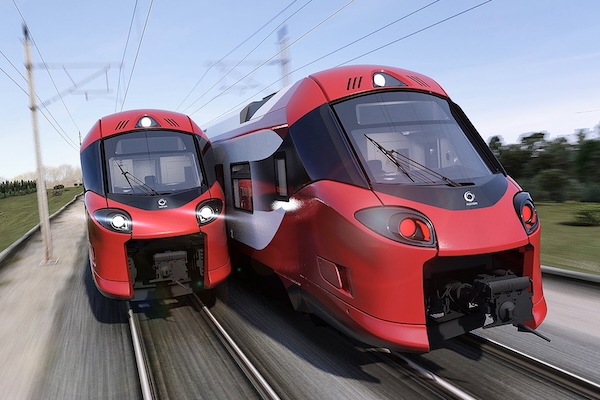
The Société Nationale des Chemins de Fer Luxembourgeois, better known to the residents of Luxembourg as train operator CFL, has been in the process of replacing and refitting its rolling stock since 2022 in an effort to increase capacity, reliability and comfort.
The most significant change has, undoubtedly, been the acquisition of 34 new trains, which have been gradually introduced to Luxembourg's rail network since early 2024. The CFL states that the new trains, called Coradia Stream High Capacity (CSHC) railcars, allow for a greater number of carriages (up to nine) within a single train configuration and offer a “generous amount of space and an open-plan layout”. They also feature additional power points for customers, WiFi antennas for internet connectivity on-the-go, improved toilet facilities and fewer restrictions in a bid to facilitate better mobility.
As a regular user of Luxembourg’s train system, having used it almost daily since 2018, I am somewhat familiar with the variety of engines and carriages used on Luxembourg’s train network. The most common carriages in use are the 87 DoSto, with their double-decker configuration, but, having been in use since 2005, they are certainly showing their age after 20 years in use. The CFL ran a refurbishment programme for these carriages between 2022 and 2024 but this concentrated mostly on upgrades to the carriage’s exterior, internal lighting and air conditioning system. Sadly, the interiors remain mostly as they were and, despite being well maintained, are showing the effects of their twenty years of service.
With a limited number of power slots, time-worn upholstery, dated toilet facilities and restrictions impeding easy access for those with limited mobility, the news of new carriages being introduced was, I imagine, very much welcomed by all customers of the CFL.
Unfortunately, for me, the introduction of the new 2400 series carriages has mostly concentrated on the southern part of the network, with us northerners stuck with the 87 DoSto and, on certain shorter routes, the very old 2000 series trains, with their curtains and upholstery that feel like they have been lifted straight out of a 1980s budget hotel. However, on occasion, a CSHC has popped up on the Troisvierges route and I’ve had the opportunity to try out the CFL’s shiny new flagship train.
As a Scotsman, trainspotting for me is a book by Irvine Welsh and not a hobby involving timetables and catalogues of locomotives, but, as a passenger, any upgrade to my journey to and from the city is certainly something to get excited about. After all, I’ve endured many a journey standing up due to overcrowding. There have been more than a few occasions where I’ve sat disgruntled at the lack of charge in my phone, with the limited number of charging points in the carriage already being utilised by other passengers. There have been times where the only seat available to me was the one with what appeared to be prehistoric traces of chewing gum fused into the upholstery. Then there is what I would refer to as “train bin roulette”, where the small metal waste receptacle located by the window is filled with all manner of things you’d rather not have to sit next to. The comfort of the seats can also be brought into question, with the padding deadened from decades of use and industrial cleaning. And let’s not even touch on the trial by water that is the dreaded train toilet. A test of will that I can only imagine is far worse for women than for men.
There is also the issue of reliability. I have, on more than one occasion, had to vacate a train due to problems with the doors preventing the journey from continuing. I’ve also been sat on a train that had, up until the station it had just stopped at, appeared to be functioning perfectly but was now, somehow, “supprimé” (cancelled), with angry passengers being told to alight and find another service to their destination.
Did I believe that the new shiny carriages would remove all the woes I’ve experienced with their older, weathered siblings? Did I believe that they would make my journeys more comfortable and less likely to be cancelled? Did I believe that someone, anyone, would understand my fear of Train Bin Roulette™ and find a solution?
As with all things, the answer(s) ended up somewhere inbetween. The new trains are certainly cleaner and quieter than their aged predecessors. However, they too would have, once upon a time, been quieter and cleaner when they first rolled out. The seats are certainly more comfortable due to their more ergonomic design but, oddly, the armrests seem to be slightly higher, making them rather uncomfortable to use. They still serve as a divider between you and your neighbouring passenger but surely their main purpose is for comfort as much as containment. Most seats now have a fold-down table but they are so deep when in use that they limit your ability to move in your seat and I’m not exactly the stoutest of people. Mercifully, the waste receptacles have gone and this provides more leg room. But first it giveth then it taketh away, as I soon realised passengers are now at the mercy of the ethics of whoever has sat in that seat before them. With nowhere for people to put their banana skins or cotton buds (real life examples I have experienced), it seems that leaving one’s mess on the floor or squashed into the air conditioning strip which runs the length of the carriage’s windows is the new Train Bin Roulette.
Thankfully, I can attempt to ignore these unexpected companions to my journey by having a fully charged phone, tablet or laptop, with almost all seats featuring both an electrical outlet and a USB charging socket. There is also added comfort with improved blinds for when the sun occasionally shows itself in the Grand Duchy. The air conditioning also appears to be more effective, with the once prominent tang of the carriage’s air less prominent than usual on busy journeys. However, I’ll reserve full judgement on that aspect until a summer’s worth of journeys have been completed.
Oddly, the small window seat tables which were a feature of the four seat sections of the carriage are no longer present. The overhead storage racks also appear to be, incredibly, even less accommodating than those on the older 87 DoSto carriages. This seems to be a result of the roof of the carriages being more aggressively tapered. It almost makes the upper sections of the carriages feel a touch more claustrophobic but it may just be an optical illusion on my part.
In terms of accessibility there appear to be small improvements, with wider, single doors allowing easier access to the carriages and the central guide rails at the doors being removed completed but I still feel for anyone trying to complete a journey by train while navigating the world in a wheelchair. The installation of guide poles for helping ascend to/descend from the upper decks is certainly welcome, especially when trying to do so when the train is in motion but the steps are still quite tight and are especially problematic when many people are attempting to leave or board the train at the same time.
On the lower decks, there are a couple of odd design changes which I believe hinder accessibility more than help it. Firstly, in certain sections, there is the odd addition of a metal and rubber strip which runs perpendicularly on the floor beneath the seats. In wet weather, this is likely to be a slip hazard when standing up or taking your seat. Secondly, much of the seating on the lower and single floor decks now sit on a raised platform, which may present a hazard/difficulty to those with limited mobility or a trip hazard should you have been napping and suddenly realise that you’ve arrived at your destination and must exit quickly.
When it comes to capacity and being able to secure a seat on every journey, it should be noted that the number of travellers on the network has increased by 85% in the last fifteen years. With the 87 DoSto carriages still in service and 34 new Coradia trains introduced to the network in full by 2026, there will be a noticeable increase in the number of seats available, a figure which has steadily been increasing from 27,200 seats in 2018 to an expected 38,591 by 2026.
In terms of the improvements to the toilet facilities, I was unable to check as they were continually occupied during the two journeys I have taken in the new carriages. From the outside they certainly look like an improvement, but I’ll have to wait to find out if, like the removal of the waste receptacles, that proves to be a double-edged sword.
Surely the most important improvement relates to reliability and there is, so far, no argument that the new trains are more reliable in their operation. They may still be at the mercy of the regular technical faults which plague Luxembourg’s train network but that is a different issue which, hopefully, is being dealt with through the numerous line improvements taking place across the country.
In conclusion, I have to ask myself, is it fair to complain when all of this is free? To a point, I think it is. After all, these upgrades have been funded by taxpayer’s money. These complaints could be regarded as being overly picky and there are design and budget constraints to consider but, after 20 years, I had hoped that the step from the carriages of old to the carriages of today (and tomorrow) would have been more obviously significant. However, I’m sure the trainspotters of Luxembourg absolutely love them.








